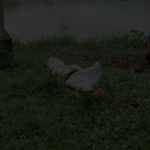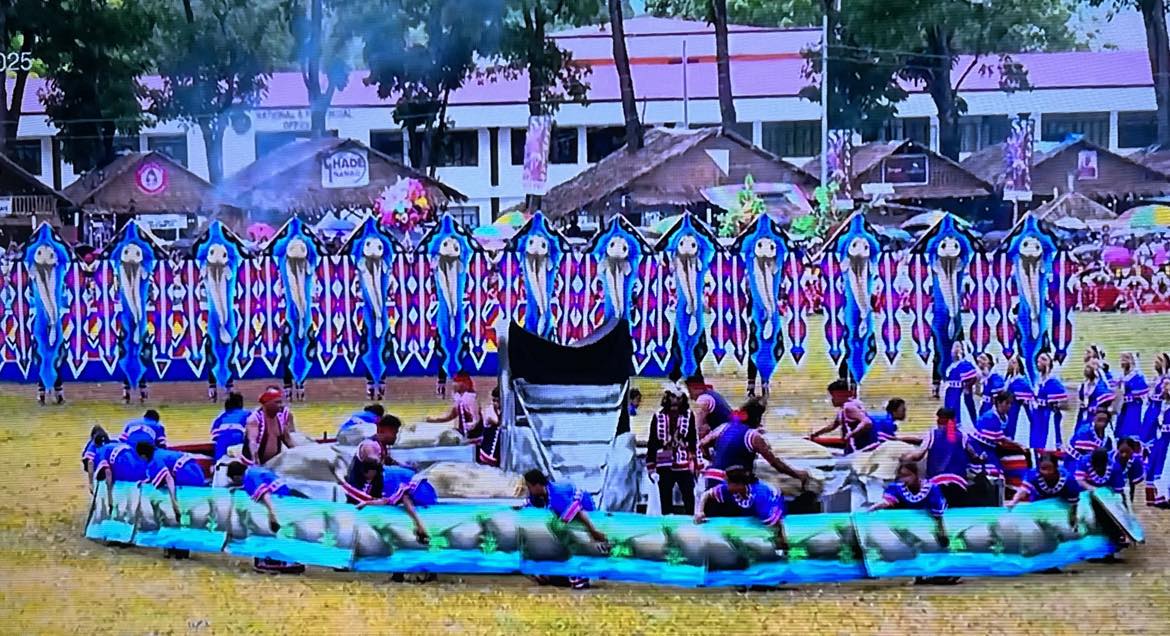Photograb courtesy of Bukidnon Kaamulan Livestream
MALAYBALAY CITY (BukidnonNews.Net/12 April 2025)—-In this year’s Kaamulan 2025, the municipality of Cabanglasan captivates audiences with its street dancing presentation titled “Pangulin-ulin: Thanksgiving for Safety and Prosperity.”
The performance retells the ancestral story of Apo Bagod, the first settler of an unnamed, bountiful river later called Umayam—“a place of plenty.”
Guided by dreams and the spirit Moulin-ulin, Apo Bagod established his family along the river, beginning a legacy of harmony with nature and the spiritual world.
Generations later, a descendant Datu, in search of new land, arrived at the same river with his community. Through the sacred Panalawahig ritual, they sought protection and guidance from the spirits. Their faith was tested when a child mysteriously disappeared by the river, prompting the Datu to pray and chant a limbay in desperation.
A miraculous encounter followed, as a guardian spirit—Bulalakaw tè Talawahig—appeared in the form of a White Snakehead Fish and led them to the missing child.
The Datu then performed the Panlisig to ward off malevolent forces and the Haklaran to offer thanks and seek protection from illness and disaster. To outwit evil spirits, men danced in skirts, followed by joyful traditional dances like Binaylan and Binanog.
The story reflects Cabanglasan’s deep respect for ancestral wisdom, spiritual traditions, and communal unity. Through Pangulin-ulin, Cabanglasan not only honors its cultural roots but also strengthens its identity as a people deeply connected to their land, river, and beliefs. (BukidnonNews.Net based on original text)
“PANGULIN-ULIN: THANKSGIVING FOR SAFETY AND PROSPERITY”
Apo Bagod was the first inhabitant of a then unnamed river which was abundant with fish and other marine life. Through dreams, he was guided by the spirit called “Moulin-ulin” as to the tasks that have to be done. The spirit also revealed to him the name of the river, “Kahungayaman” and was later named by Apo Bagod as “Umayam” which means a place of plenty. There, he met his wife Maenlèly and grew their family.
Years later, a Datu who is a descendant of Datu Bagod together with his community came in search for a new place to settle. Guided by his “abyan” (a spirit companion), they arrived at a place along the Umayam River. There, they performed the “Panalawahig”, a ritual asking “Moulin-ulin” and the good spirits for blessings and protection. However, sometime later, a child playing at the river disappeared.
The Datu and the community frantically searched, but the child was nowhere to be found. Desperate, the Datu decided to seek help from the “Moulin-ulin” by praying at the river and chanted a “limbay” imploring for help.
It was then that the Datu saw the “Bulalakaw tè Talawahig” (a spirit that guards the river) in the form of a White Snakehead Fish (puti nga halo-an) who implied that the child is on a nearby rock.
Indeed, the child was found half conscious and slightly dazed. The Datu performed the “Panlisig”, a ritual to drive away the bad spirit believed to have caused the child’s condition.
Afterwards, the Datu performed the “Haklaran”, to honor the “Moulin-ulin” and seek protection from calamities and illnesses. While dancing during the ritual, the men wore skirts to deceive the malevolent spirit into believing that the dancers are weak beings.
The community celebrated their renewed safety and prosperity with dances like the “Binaylan” and “Binanog”, marking a new milestone for the Umayamnons. The Umayam River and the rituals became central to their identity, symbolizing their uniqueness as a tribe in harmony with their spiritual beliefs.









